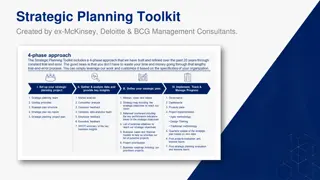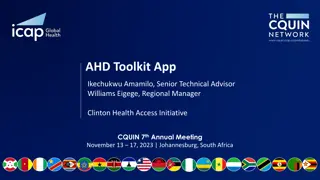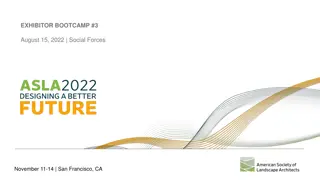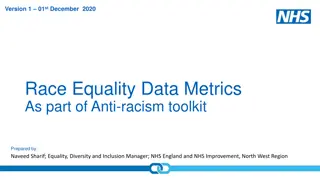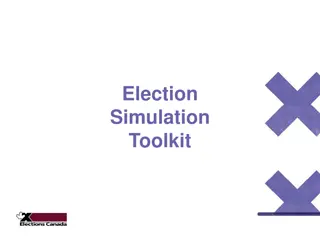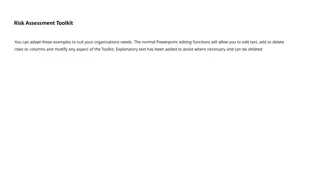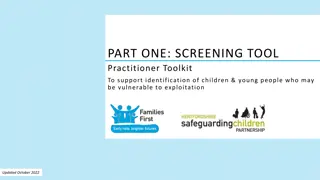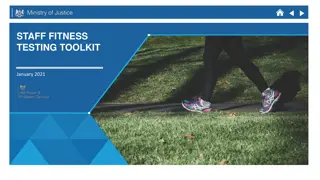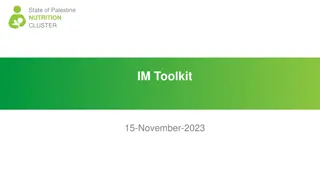
Introduction to SPICE Toolkits Navigation
Explore the Navigation and Ancillary Information Facility (N.IF) Toolkit architecture, features, versions, and capabilities. Learn about the SPICE Toolkit available in Fortran, C, IDL, MATLAB, and Java, along with other toolkits like Python and Ruby. Discover the toolkit contents, application programs, utility programs, and more.
Download Presentation

Please find below an Image/Link to download the presentation.
The content on the website is provided AS IS for your information and personal use only. It may not be sold, licensed, or shared on other websites without obtaining consent from the author. If you encounter any issues during the download, it is possible that the publisher has removed the file from their server.
You are allowed to download the files provided on this website for personal or commercial use, subject to the condition that they are used lawfully. All files are the property of their respective owners.
The content on the website is provided AS IS for your information and personal use only. It may not be sold, licensed, or shared on other websites without obtaining consent from the author.
E N D
Presentation Transcript
N IF Navigation and Ancillary Information Facility Introduction to the Family of SPICE Toolkits April 2023 (Class version)
N IF Topics Navigation and Ancillary Information Facility Toolkit Architecture Toolkit Contents Toolkit Characteristics Toolkit Versions Toolkit Capabilities Toolkit Directory Structure Toolkit Application Programs Toolkit Utility Programs Toolkit Documentation 2 Introduction to the SPICE Toolkit
N IF Toolkit Architecture (1) Navigation and Ancillary Information Facility The SPICE Toolkit is officially available in Fortran 77, C, IDL and MATLAB. https://naif.jpl.nasa.gov/naif/toolkit.html A beta Java Native Interface version (JNISpice) is also available https://naif.jpl.nasa.gov/pub/naif/misc/JNISpice/ 3 Introduction to the SPICE Toolkit
N IF Toolkit Architecture (2) Navigation and Ancillary Information Facility The Toolkits are packaged and delivered as standalone products. The IDL, MATLAB and JNISpice Toolkits by necessity also include the complete C Toolkit. Other people have created Python, Ruby, Swift, Julia, Rust, and Unreal Engine toolkits, available from their own websites, linked from the NAIF server Useful Links page: https://naif.jpl.nasa.gov/naif/links.html NAIF has NOT been involved in creating, testing or documenting these. Check with their authors about functionality and details. 4 Introduction to the SPICE Toolkit
N IF Toolkit Architecture Pictorial Navigation and Ancillary Information Facility Java User s Application Program IDL User s Application Program Fortran User s Application Program C MATLAB User s Application Program User s Application Program Java Wrappers C Interface Routines ANSI C Wrappers Matlab Wrappers C Interface Routines C Interface Routines ANSI C Wrappers ANSI C Wrappers ANSI C Wrappers ANSI Fortran 77 f2c Translated C Translated C Translated C Translated C Application and Utility Programs Application and Utility Programs Application and Utility Programs Application and Utility Programs Application and Utility Programs f2c Language FORTRAN C IDL MATLAB Java Product name Toolkit CSPICE Icy Mice JNISpice (Documentation needs to be improved) 5 Introduction to the SPICE Toolkit
N IF Toolkit Contents Navigation and Ancillary Information Facility Software Subroutine libraries, with source code SPICELIB (Fortran) CSPICE (C) Icy (C) Mice (C and Matlab scripts) Executable programs Application and utility programs A few example programs (called cookbook programs) Installation/build scripts (normally you do NOT need to use these) Documentation Available in plain text and HTML Example Data Sample kernel files (supplied only for use with cookbook example programs, not valid for general use). 6 Introduction to the SPICE Toolkit
N IF Toolkit Characteristics Navigation and Ancillary Information Facility Computations are identical in all languages. For a given computer and operating system, all Toolkits use identical kernel files. Refer to the Porting Kernels tutorial for information about using kernels received from a machine different from what you are using. Code is well tested before being released to users. New Toolkits are always backwards compatible. An application that worked when linked against an older Toolkit will link and work, without need for changes, using a new Toolkit. Past functionality is never changed or removed, except that: enhancements of existing routines are allowed. NAIF reserves the right to fix bugs. Extensive user-oriented documentation is provided. Includes highly documented source code. 7 Introduction to the SPICE Toolkit
N IF Toolkit Versions Navigation and Ancillary Information Facility Toolkit Version SPICE Toolkits have an associated Version number Example: N0067 (also written as N67 ) The version number applies to all language implementations for all supported platforms. When does NAIF release a new SPICE Toolkit version? Not according to a fixed schedule Primarily driven by availability of significant new capabilities For example, addition of the digital shape kernel subsystem (DSK) On rare occasion a Toolkit update is released to fix bugs, improve documentation, or satisfy an urgent request from a flight project. 8 Introduction to the SPICE Toolkit
N IF Toolkit Library Overview Navigation and Ancillary Information Facility Toolkit libraries contain a broad set of capabilities related to the computations needed for determining observation geometry and time conversions. Examples appear on the next several pages Not all functionality is present in all four language versions of the Toolkit library. The Fortran (Toolkit) and C (CSPICE) Toolkits provide almost identical functionality. The IDL (Icy) and MATLAB (Mice) Toolkits duplicate most but not all of the functionality available in the C Toolkits. We add additional interfaces as time permits. 9 Introduction to the SPICE Toolkit
N IF Toolkit Library Capabilities (1) Navigation and Ancillary Information Facility Kernel read access Load kernels Get state or position vectors (SPK) Get orientation of planets, natural satellites, etc. (PCK) Get body shape parameters or physical constants (PCK) Get orientation of spacecraft or spacecraft instruments or structures (CK, FK) Get instrument parameters (e.g., FOV) (IK) Get digital shape data (DSK) Query binary EK files (EK-ESQ) Kernel write access for binary kernels SPK writers CK writers PCK writers (only for binary PCK files) DSK writers 10 Introduction to the SPICE Toolkit
N IF Toolkit Library Capabilities (2) Navigation and Ancillary Information Facility Additional ephemeris functions Classical osculating elements Two-body Keplerian propagation NORAD two line elements sets (TLE) propagation Current SPICE implementation of the NORAD propagator based on Vallado 2006 [2]. Light time and Stellar aberration computation Frame transformations Obtain 3x3 matrices for frame transformations of positions Obtain 6x6 matrices for frame transformations of states Time conversions Conversion between standard systems: TDB, TT (TDT), UTC Conversion between SCLK and other systems Parsing and formatting Geometry finder calculations Find times or time spans when a specified geometric condition is met Find times or time spans when a specified geometric parameter is within a given range (by performing two searches), or is at a maximum or minimum 11 Introduction to the SPICE Toolkit
N IF Toolkit Library Capabilities (3) Navigation and Ancillary Information Facility Math Vector/Matrix operations Rotations, Euler angles, quaternions Coordinate conversion (systems: latitudinal, cylindrical, rectangular, RA and DEC, spherical, geodetic, planetographic) Geometry: ellipsoids, ellipses, planes High-level functions: illumination angles, sub-observer point, sub-solar point, surface intercept point. Constants Julian date of epoch J2000, SPD (seconds per day), PI, etc. Strings Parsing: find tokens, words Numeric conversion Pattern matching Replace marker, substring Suffix, prefix Case conversion Find first/last non-blank character, first/last printing character 12 Introduction to the SPICE Toolkit
N IF Toolkit Library Capabilities (4) Navigation and Ancillary Information Facility Arrays Sorting, finding order vector, reordering Searching: linear, binary Insertion and deletion Name/ID code conversion Bodies Frames Surfaces I/O support Logical unit management (for Fortran toolkits) Open, read, write text files Kernel pool API Exception handling Control exception handling behavior: mode, set message, assign output device. Advanced data types Cells, Sets Windows (sometimes called schedules) Symbol Tables Planes, Ellipses 13 Introduction to the SPICE Toolkit
N IF Toolkit Directory Structure (1) Navigation and Ancillary Information Facility The directory structures for the four kinds of Toolkits are almost identical. However The CSPICE, Icy, Mice, and JNISpice Toolkits also have a directory for include files. The names for application source code directories in CSPICE, Icy, Mice, and JNISpice differ slightly from those in the Fortran toolkit. Icy, Mice, and JNISpice include additional directories for : Icy/Mice/JNISpice source code Icy/Mice cookbook programs The top level directory name for each Toolkit is: toolkit for Fortran Toolkits. cspice for C Toolkits. icy for IDL Toolkits. mice for Matlab Toolkits JNISpice for Java Toolkits 14 Introduction to the SPICE Toolkit
N IF Toolkit Directory Structure (2) Navigation and Ancillary Information Facility The next level is comprised of: data Cookbook example kernels (use ONLY for training with cookbook programs). doc Text documents *.req, *.ug, spicelib.idx/cspice.idx, whats.new, dscriptn.txt, version.txt. Subdirectory containing HTML documentation, called html . The html subdirectory contains a single file the top level HTML documentation index called index.html and a number of subdirectories, one for each of the various groups of documents in HTML format (API Reference Guide pages, User s Guide pages, etc.). etc In most Toolkits this directory is empty. exe Executables for some SPICE application and utility programs: brief, chronos, ckbrief, commnt, dskbrief, dskexp, frmdiff, inspekt, mkdsk, mkspk, msopck, spacit, spkdiff, spkmerge, tobin, toxfr, version. Executables for the several cookbook example programs: simple, states, subpt, tictoc 15 Introduction to the SPICE Toolkit
N IF Toolkit Directory Structure (3) Navigation and Ancillary Information Facility include (applies only to CSPICE, Icy, Mice, and JNISpice) API header files. File to include in callers of CSPICE is SpiceUsr.h lib Toolkit libraries: For Fortran Toolkits spicelib.a or spicelib.lib (public modules; use these) support.a or support.lib (supporting modules; don t use these) For C Toolkits cspice.a or cspice.lib (public modules; use these) csupport.a or csupport.lib (supporting modules; don t use these) For Icy Toolkits: icy.so or icy.dll (shared object library) icy.dlm (dynamically loadable module) cspice.a or cspice.lib, and csupport.a or csupport.lib For Mice Toolkits: mice.mex* (shared object library) cspice.a or cspice.lib, and csupport.a or csupport.lib For JNISpice Toolkits: libJNISpice.so or libJNISpice.lib (shared object library) cspice.a or cspice.lib, and csupport.a or csupport.lib src Source code directories for executables and libraries Files have type *.f, *.for, *.inc, *.pgm, *.c, *.h, *.x, *.pro, *.m, *.java, *.class, *.html *.h files appearing here are not part of the user API 16 Introduction to the SPICE Toolkit
N IF Toolkit Application Programs Navigation and Ancillary Information Facility SPICE Toolkit application programs are available to: create most binary kernel types compare or analyze certain kernel types do various kinds of time conversions and more See the toolkit_apps tutorial for details Some additional application programs are available only from the NAIF website: http://naif.jpl.nasa.gov/naif/utilities.html See the non_toolkit_apps tutorial for details 17 Introduction to the SPICE Toolkit
N IF Toolkit Utility Programs Navigation and Ancillary Information Facility SPICE Toolkit utility programs are available to: add comments to binary kernels commnt read comments from binary kernels commnt, spacit inspekt (only for EK/ESQ files) summarize coverage of binary kernels brief, ckbrief, dskbrief, spacit merge or subset SPK files spkmerge and more See the toolkit_apps tutorial for details 18 Introduction to the SPICE Toolkit
N IF Toolkit Documentation (1) Navigation and Ancillary Information Facility All Toolkits include documentation in plain text and HTML formats. Plain text documents are located under the doc directory HTML documents are located under the <toolkit_name>/doc/html (Unix) or <toolkit name>\doc\html (Windows) directory index.html is the top level index your starting point All Toolkits include the following kinds of documents Module headers They act as primary functional specification: I/O, exceptions, particulars defining behavior of module They contain code examples - Required Reading documents Extensive technical references for principal subsystems Provide many low-level details Provide code examples Not all Required Readings were adapted for all languages Some of the Required Reading documents provided with CSPICE are based upon Fortran SPICE Some of the Required Readings for Icy or Mice toolkits are based upon CSPICE User s Guides Tell how to use the utility and application programs 19 Introduction to the SPICE Toolkit
N IF Toolkit Documentation (2) Navigation and Ancillary Information Facility Other documents Permuted Index Maps phrases describing functionality to corresponding module names and file names Shows names of all entry points in Fortran toolkit APIs Toolkit Description Describes the directory structure and contents of an installed Toolkit Customized based on set of delivered products and platform Introduction to SPICE Contains a brief introduction to the Toolkit and SPICE system What s New in SPICE Describes new features and bug fixes in each Toolkit release, covering the last 20 years. Toolkit Version Description Indicates Toolkit version You can also use Google to find any of the Toolkit documents E.g., search on the API name (e.g. spkezr, spkezr_c, or cspice_spkezr (for Icy and Mice)) in combination with naif and spice E.g. search on the document name (e.g. CK Required Reading, spkdiff user s guide) 20 Introduction to the SPICE Toolkit



